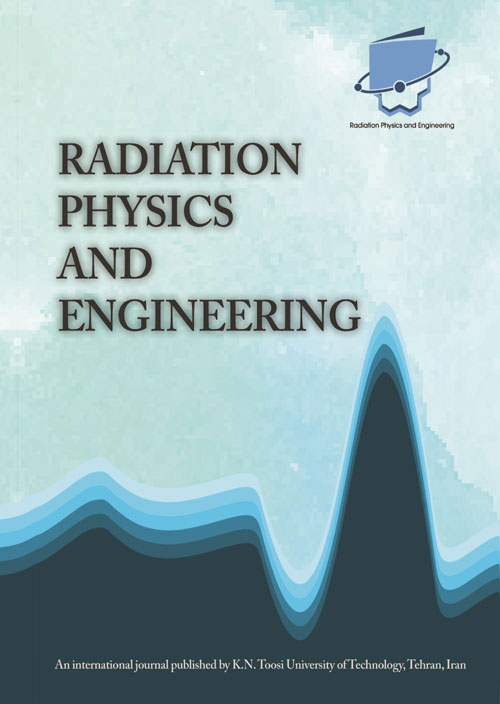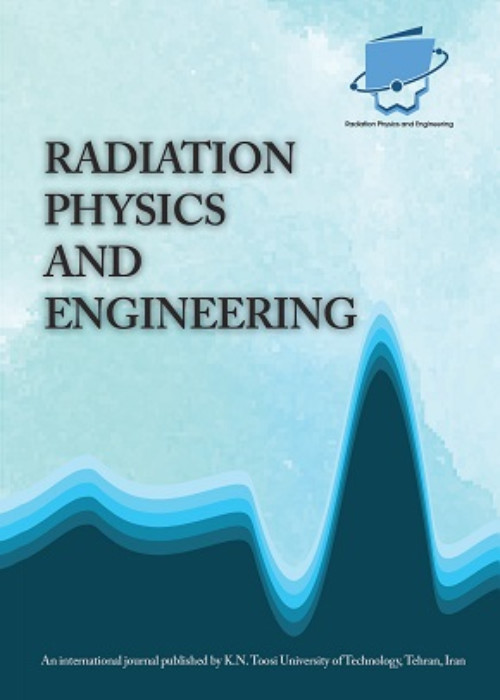فهرست مطالب

Radiation Physics and Engineering
Volume:2 Issue: 4, Autumn 2021
- تاریخ انتشار: 1400/09/06
- تعداد عناوین: 6
-
-
Pages 1-9The neutronic safety parameters determine reactor dynamic response. These parameters change as a function of core inventory during reactor cycle. Therefore, assessment of reactor behavior throughout operational cycle is an important issue in reactor safety analysis for transients. The purpose of the present study is to evaluate SMART reactor response to changes in neutronic safety parameters during reactor cycle in reactivity insertion accident condition. MCNPX 2.6 nuclear code is utilized to calculate neutronic safety parameters throughout reactor cycle. The reactor dynamic model is simulated based on point kinetic equations and lumped temperatures to predict reactor response to ramp reactivity insertion. Based on this approach, the effect of neutronic parameters on reactor behavior are investigated in the beginning and end of cycle under reactivity transients. Hot full and zero power operational reactor states are considered in the analysis. Results illustrate that reactor at end of cycle has faster response with smaller transient power peak during reactivity insertion accident compared to beginning of cycle. The neutronic parameters, specifically negative feedbacks at both beginning and end of reactor cycle guarantee the safe performance of reactor at all examined conditions. The detailed comparative results are explained in the paper.Keywords: SMART, Dynamic Response, Reactivity Insertion Accident, Safety Parameters
-
Pages 11-18The scattering problems, in the presence of an external potential field, have become highly interesting topics in relativistic and non-relativistic quantum mechanics. It is well known that the scattering of a relativistic particle in the field of a potential can be treated exactly by finding the continuum solutions of the Dirac equation. In this research, we obtain the exact solution to the Dirac equation with the Pöschl-Teller double ring-shaped Coulomb (PTDRSC) potential for any spin-orbit quantum number k. The relativistic scattering amplitude for spin 1/2 particles in the field of this potential has been studied. The wave functions are being expressed in terms of the hyper-geometric series of the continuous states on the k/2π scale. In addition, a formula for the phase shifts has also been found. In the nonrelativistic limits, our solution to the Dirac particle converges to that of the Schrödinger one. At the high temperature, the partition function is being calculated in order to study the behavior of some thermodynamic properties.Keywords: Dirac equation, Pö schl-Teller doubles ring-shaped Coulomb potential, Scattering Amplitude
-
Pages 19-27Canadian GEN IV Super Critical Water Reactor (Canadian-SCWR) is a combination version of conventional CANDU reactor with the using super critical water as coolant. Thermal-hydraulic analysis of a nuclear reactor is done to ensure that reactor will work in its safety margins. In this study, thermal hydraulic analysis of Canadian-SCWR is conducted by numerically solving of conservation equations by a porous media approach. The latest concept of Canadian-SCWR core was used for this purpose. In this concept, in each fuel bundles, super critical water flows in two pass and low pressure and low temperature heavy water moderator flows around fuel channel in the Calandria vessel, separately. Average axial temperature, density, heat capacity, pressure and velocity of supercritical water was estimated in two regions of fuel channels (two pass) i.e centeral flow tubes and the fuel rods channel. Compared to the literature, there is a good agreement between our results and the reported results.Keywords: Canadian-SCWR, Porous media approach, thermal-hydraulic analysis, supercritical water coolant
-
Pages 29-37Gamma radiation shielding of baked and unbaked granite bricks produced with 0%, 10%, 20%, 30%, 40%, and 50% of kaolin powder were experimentally and theoretically assessed for possible deployment in liquid radioactive waste storage. A 3×3 inches NaI(Ti) detector and WinXCOM program were used to measure the linear attenuation coefficients at different energies. Elements composition of samples were analyzed using particle induced X-ray emission (PIXE) spectroscopy. Results show that adding kaolin to granite positively reduced the liquid permeability coefficients of the bricks but negatively reduced the shielding properties of the bricks. Optimum results were obtained from unbaked sample of granite brick produced with 50% of micro scale kaolin powder (GK50) with mass attenuation coefficient of 0.0663, 0.0572 and 0.0552 cm2.g-1, radiation protection efficiency (RPE) of 38.36%, 34.11% and 33.13% for radiation energies levels of 661.6, 1173.2, and 1332.5 keV respectively and liquid permeability coefficient of 6.53×10-11 m.s-1. The study concludes that all brick samples were thermally stable, good in gamma radiation shielding and efficient in liquid radioactive waste immobilization.Keywords: Granite, Kaolin, Gamma shielding, Radioactive waste management, Liquid Permeability
-
Pages 39-46
The effective β-fraction has a key role in the dynamic response of the reactor. This study aims to assess the suitability and accuracy of the detailed models of DRAGON5 and DONJON5 code for estimation of the effective fraction of delayed neutron for the VVER-1000 reactor core. DRAGON5 is adopted to homogenize and condense lattice physics constants of fuel assemblies during fuel burnup, followed by DONJON5, which is used to calculate forward and adjoint flux profiles on the reactor core geometry. A thermal-hydraulic subroutine is developed for VVER-1000 reactor hollow fuel pellets to embody the reactivity feedback raised by changing the reactor power profile. The effective β-fraction is evaluated for each fissile and fertile isotopes in terms of fuel burnup. The results of the coupling scheme are evaluated using the KASKAD code package of Bushehr NPP-I (BNPP-I). The results indicate that the use of SHI and SYBILT modules of DRAGON5 are essential to achieve reasonably precise resolution.
Keywords: Effective delayed neutron fraction, VVER-1000, Burnup, DRAGON5, DONJON5 -
Pages 47-56
The occurrence of core uncovering following a loss of coolant accident is conceivable and should be taken into account for its significant possible consequences. Source terms are calculated using ORIGEN 2.1 code, and the gamma dose of the uncovered core is calculated for three different normal and anticipated accidents scenarios. Under containment gamma dose rates have been calculated analytically as well as using MCNPX 2.6.0 code. The uncovered core of the Tehran research reactor is supposed to operate in nominated power of 5 MW for 30 days. The results illustrated that the under-containment dose rate of gamma in some locations would be about 200 Svh-1, far from the annual occupational exposure limit of 50 mSv. For preventing this occurrence, it would be possible to use an emergency make-up tank as an engineered safety feature, with functions of the avoidance of damaging fuel after the loss of coolant accident as well as controlling exposure from the core.
Keywords: Research Reactor, Total core uncovering, Gamma dose, Emergency make-up tank


